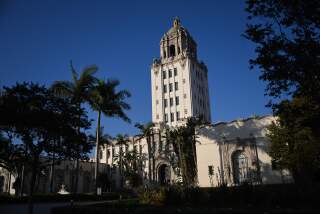A building fee-for-all
- Share via
Builders, no strangers to the escalating costs of construction materials, have something else to feed into their calculators: the ever-rising fees for complying with government mandates.
“Fees,” said Mike Dwight, vice president of Hesperia-based Frontier Homes, “are the bane of our lives.”
In an era of fewer federal, state and local dollars, city governments annually are charging developers more annually to pay for infrastructure than ever before. The fees are used for schools, parks, grading and sanitation, to name a few. And they sometimes double from one year to the next.
Most builders agree that they should pay some of the costs, because they create the need for the services and benefit from the sale of new homes. But some complain that new-home buyers, in essence, end up shouldering the cost for services that in many cases all city residents enjoy.
“We’ve shifted the burden of building new roads from the general populace to new-home buyers,” said Dan Kassel, co-president of Granite Homes in Irvine. “The added costs have made many new homes unaffordable.”
In far-flung exurbs, at least 5% of the cost of homes, Dwight says, is attributed to government-mandated fees. In L.A. and some Orange County cities, fees typically make up 10% to 15% of the price, the California Building Industry Assn. says, or $40,000 to $60,000 per home.
So-called impact fees are part of the development approval process and are not taxes imposed on property owners. Developers must pay these fees and meet city planning and zoning stipulations before cities grant approval for the projects. Builders then tack those costs onto the price of homes sold; on smaller projects, the homeowners -- especially if the job is a remodel -- often pay the fees outright.
Permit fees are determined according to a valuation table, which calculates the costs by the square footage of the home or addition and the type of construction. The table also computes the expected number of city inspections necessary, based on averages, said Bob Steinbach, assistant bureau chief of the City of Los Angeles Department of Building and Safety. He added that the city’s permit and plan-check fees have remained unchanged for 14 years.
But infrastructure fees, such as those for schools, parks, transportation and sewers, are set by city, county and state agencies and typically rise annually. They are paid with the permit fees, but then are transferred to their respective departments’ accounts, Steinbach said.
There can be as many as 20 fees imposed on a new structure, a virtual alphabet soup: E.Q. Instrumentation; O.S. Surcharge; E.I. Commercial, for example. If developers want to move to the front of the approval-process line, they pay more, said L.A. architect Stan Brendt.
“The surcharge used to cut the plan-check time in Los Angeles from seven weeks to two or three,” Brendt said. “Now ‘expediting’ means 10 weeks instead of 13 or 14.”
School charges often are higher than building-permit fees. Santa Monica architect Brant Gordon’s client will pay $4,387 in total fees for a proposed $190,000 home renovation in Van Nuys, $2,214 of which are school fees. A recent client of Brendt’s paid $22,518 for a permit to build a 37-unit apartment building in Van Nuys; the school fees were $212,033. Total fees for the structure were $258,224.
Riverside County instituted Transportation Uniform Mitigation Fees for new developments in the Coachella Valley and West Riverside County several years ago to help fund transportation improvements. The charges are based on average weekday trips generated by a project. Builder Kassel’s fees initially were about $4,500 per lot; today they’re $9,600 per parcel, he said.
There is a good reason for the high cost of construction fees, government officials say: Some benefit new communities and others pay for inspections and other services necessary to builders. Building and safety’s one-stop surcharge, for example, enables developers and architects to submit their plans for approval at one office, rather than running around to the city-planning, public works and other counters in separate buildings.
“The fees we collect,” Steinbach said, “are simply paying for the services they receive.”
The city of Hesperia in San Bernardino County, responding to a 23.7% increase in population since 2000 and an expected doubling of the current 81,000 residents by 2030, has proposed an increase in the public-safety portion of its development impact fees to expand two existing fire stations and add four new ones. Developer fees for streets would climb from $6,768 -- an amount approved in July 2006 -- to $8,957, which would go into effect in July 2007. Fire fees would increase from $266 to $1,425.
“If the existing population paid these fees, they would be paying twice,” said Melanie Eustice, a management analyst for Hesperia. The city needs “developers’ fee adjustments to keep up with the increase in police and fire calls that new building brings.”
More to Read
Inside the business of entertainment
The Wide Shot brings you news, analysis and insights on everything from streaming wars to production — and what it all means for the future.
You may occasionally receive promotional content from the Los Angeles Times.










